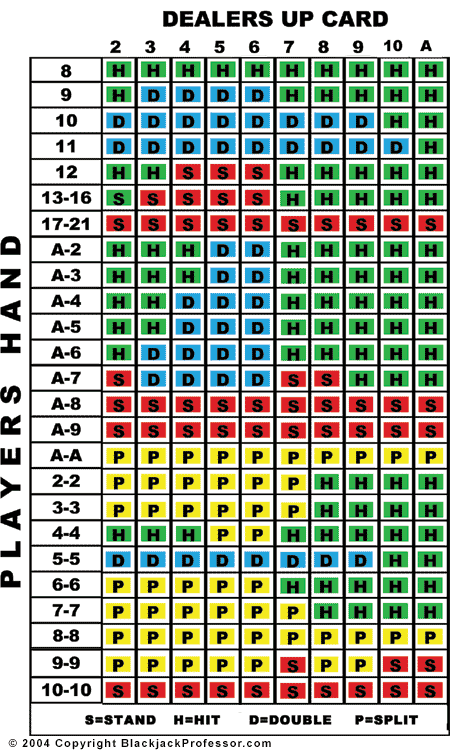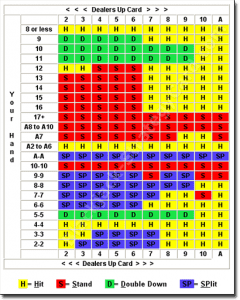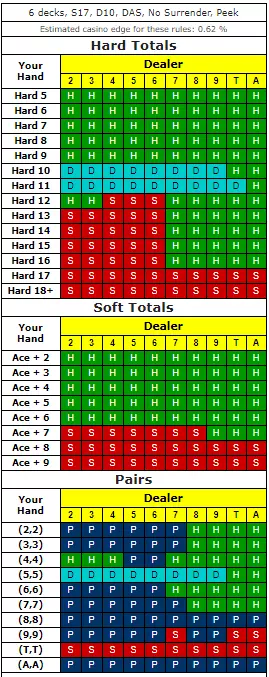Blackjack Basic Strategy for Splitting Pairs of Fours How to Play a Pair of 4's in Blackjack. Hard hands: Hard 8 or less - Hard 9 - Hard 10 - Hard 11 - Hard 12 - Hard 13 - 16 - Hard 17 to 21 Soft hands: Soft 13 - 14 - Soft 15 - 16 - Soft 17 - Soft 18 - Soft 19 to 21.


- Pairs of 2's, 3's, 7's. Split o/wise Hit. Split pairs of 2s, 3s and 7s against the dealer's up cards from 2-7, otherwise hit. The dealer has a high possibility.
- This strategy is a way of increasing the probability of hitting a Perfect Pair among the first few hands. In case, you fail to hit a Perfect Pair, the loss is just $100. Regular blackjack is played normally using the basic blackjack strategies. It should be remembered here.
- The basic strategy for pair splitting is shown below in a black and white table followed by a color-coded chart for single-, double-, and 4/6/8-deck games. The black and white strategy table shows your pair in the first column and, in the second column, what the dealer’s upcard should be for you to split.

Splittingaces and eights is part of blackjackbasic strategy. Rules vary across gambling establishments regarding resplitting, doubling, multiple card draws, and the payout for blackjack, and there are conditional strategic responses that depend upon the number of decks used, the frequency of shuffling and dealer's cards. However, regardless of the various situations, the common strategic wisdom in the blackjack community is to 'Always split aces and eights' when dealt either pair as initial cards.[1] This is generally the first rule of any splitting strategy.[2]
Splitting[edit]
The object of blackjack is for a player to defeat the dealer by obtaining a total as close to 21 as possible without accumulating a total that exceeds this number.[3] In blackjack, the standard rule is that if the player is dealt a pair of identically ranked initial cards, known as a pair, the player is allowed to split them into separate hands and ask for a new second card for each while placing a full initial bet identical to the original wager with each. After placing the wager for the split hands the dealer gives the player an additional card for each split card. The two hands created by splitting are considered independently in competition against the dealer.[4][5] Splitting allows the gambler to turn a bad hand into one or two hands with a good possibility of winning. It also allows the player to double the bet when the dealer busts.[2] Some rules even allow for resplitting until the player has as many as four hands[4] or allow doubling the bet after a split so that each hand has a bet double the original.[6][7] The standard rules are that when a bet is doubled on a hand, the player is only allowed to draw one more card for that hand.[8][9]
How To Win At Blackjack Basic Strategy
Aces[edit]
A pair of aces gives the blackjack player a starting hand value of either a 2 or a soft 12 which is a problematic starting hand in either case.[2][10] Splitting aces gives a player two chances to hit 21.[11] Splitting aces is so favorable to the player that most gambling establishments have rules limiting the player's rights to do so.[2][10] In most casinos the player is only allowed to draw one card on each split ace.[8][10] As a general rule, a ten on a split ace (or vice versa) is not considered a natural blackjack and does not get any bonus.[6] Prohibiting resplitting and redoubling is also common.[2] Regardless of the payout for blackjack, the rules for resplitting, the rules for doubling, the rules for multiple card draws and the dealer's cards, one should always split aces.[10][12][13]
Eights[edit]
If a player is dealt a pair of eights, the total of 16 is considered a troublesome hand. In fact, the value 16 is said to be the worst hand one can have in blackjack.[10] Since sixteen of the other fifty cards have a value of 10 and four have a value of 11, there is a strong chance of getting at least an 18 with either or both split cards. A hand totaling 18 or 19 is much stronger than having a 16.[6] Splitting eights limits one's losses and improves one's hand.[10][11][12] Probabilistic research of expected value scenarios shows that by splitting eights one can convert a hand that presents an expected loss to two hands that may present an expected profit or a reduced loss, depending on what the dealer is showing.[14] A split pair of eights is expected to win against dealer upcards of 2 through 7 and to lose less against dealer upcards of 8 through ace.[15] If a player hits on a pair of eights, he is expected to lose $52 for a $100 bet. If the player splits the eights, he is expected to lose only $43 for a $100 bet.[16]
History[edit]
Blackjack's 'Four Horsemen' (Roger Baldwin, Wilbert Cantey, Herbert Maisel and James McDermott), using adding machines, determined that splitting eights was less costly than playing the pair of eights as a 16.[17] They were part of a 1950s group that discovered that strategy could reduce the house edge to almost zero in blackjack.[18] Now a typical strategy involves the following sequence of playing decisions: one decides whether to surrender, whether to split, whether to double down, and whether to hit or stand.[19]
One of the earliest proponents of the strategy of splitting eights is Ed Thorp, who developed the strategy on an IBM 704 as part of an overall blackjack strategic theory published in Beat the Dealer: A Winning Strategy for the Game of Twenty-One in 1962.[18][20][21] Thorp was the originator of the card counting system for blackjack.[18]
Notes[edit]

- ^Gros, p. 60
- ^ abcdeOrtiz, p. 56
- ^Gros, p. 48
- ^ abGros, p. 51
- ^Jensen, pp. 22–23
- ^ abcSchneider, p. 47
- ^Gros, p. 52
- ^ abSchneider, p. 49
- ^Gros, p. 50
- ^ abcdefJensen, p. 53
- ^ abJensen, p. 56
- ^ abHagen and Wiess, pp. 68
- ^Schneider, p. 48
- ^Hagen and Wiess, pp. 66–67
- ^Scoblete, Frank. 'Why Splitting Eights At Blackjack Is An Iron Clad Rule'. Golden Touch Craps. Retrieved 24 July 2009.
- ^Tamburin, Henry (25 October 1999). 'Splitting Aces and Eights'. Casino city Times. Retrieved 24 July 2009.
- ^Snyder, Arnold (2005). 'Blackjack Basic Strategy: Aces and Eights'. Player Magazine (republished).
- ^ abcGros, p. 44
- ^Jensen, p. 51
- ^Thorpe, Beat the Dealer as cited in Snyder, Arnold citation below
- ^Levinger, Jeff (10 February 1961). 'Thorpe, 704 Beat Blackjack'(PDF). The Tech. Retrieved 30 May 2009.
References[edit]
- Dunki-Jacobs, Frits. Betting on Blackjack: A non-counter’s Breakthrough Guide to Making Profits at the Tables. Adams Media. pp. 28–34. ISBN1-58062-951-2.
- Gros, Roger. The Winner's Guide To Casino Gambling. Carlton Books Limited. pp. 44–69. ISBN1-85868-899-X.
- Hagen, Tom & Sonia Weiss (2005). The Everything Blackjack Strategy Book: Surefire ways to beat the house every time. Adams Media. pp. 66–68. ISBN1-59337-306-6.
- Jensen, Marten (2003). Beat Multiple Deck Blackjack. Cardoza Publishing. pp. 22–23, 51–56. ISBN1-58042-069-9.
- Ortiz, Darwin. Casino Gambling For The Clueless. Carol Publishing Group. pp. 55–59. ISBN0-8184-0609-7.
- Schneider, Meg Elaine. The Everything Casino Gambling Book (2nd ed.). Adams Media. pp. 47–49. ISBN1-59337-125-X.
- Thorp, Ed (1966). Beat the Dealer: A Winning Strategy for the Game of Twenty-One. Vintage. ISBN0-394-70310-3.
Perfect Pairs is one of the most popular blackjack variations and it could be found online, as well as in various brick-and-mortar casinos in the United States, Europe, Macau, and Australia. Often presented as a separate game of 21, it is actually a traditional European blackjack with a side bet called Perfect Pairs.
The game was invented by John Wicks, a professional blackjack dealer who aimed at creating a version of the classic game with a little more high-stakes action. It is typically played with 6 or 8 decks but there are also versions of the game that use fewer decks of cards. In this article, you will find the basic rules of Perfect Pairs Blackjack, its expected return, and a short explanation of whether or not players should make this side bet.
Basic Rules of Perfect Pairs Blackjack
As we have mentioned above, this game follows the European blackjack rules and uses 6 or 8 standard 52-card decks. In USA casinos, as well as in some online versions, Perfect Pairs is an American-style version of the game and uses the so-called hole card. Players who are familiar with classic blackjack will have no issues when playing the game. The only difference between Perfect Pairs and the basic game of 21 is the optional side bet called Perfect Pairs.
To make it, players need to place a bet that is the table minimum or more on the specified field on the table. This bet wins if the player receives a pair – of course, the bet applies only to the two initial cards and is separate from the main play. The payout depends on the specific pair – any two cards of the same rank pay out, but if they are also of the same color, the payout is better. If the two cards are of the same rank and suit, the payout is even higher.
Payouts and RTP
Depending on the casino or the software provider that has created the particular version of Perfect Pairs, the payouts for having a pair in the initial hand can differ slightly. Typically, games with higher payouts have slightly altered rules that favor the casino. For example, most versions of the game use either 6 or 8 decks of cards rather than the typical European blackjack, which is played with only 2 decks.
Payouts
As expected, the payouts for a blackjack, a 21 win or insurance are standard – 3:2, 1:1, and 2:1 respectively. The payouts for the different pairs usually come in several main variants.
- Mixed Pair – Two cards of the same value but different color (Ace of Hearts and Ace of Spades) 5:1, 6:1 or 7:1
- Colored Pair – Two cards of the same value and color (Ten of Hearts and Ten of Diamonds), 10:1, 12:1 or 15:1
- Perfect Pair – Two cards of the same value, color, and suit (Five of Clubs and Five of Clubs), 25:1 or 30:1
How To Win Blackjack Strategy
Return to Player
The expected return or RTP (Return to Player) rate depends on the particular paytable and the specific rules of the variation you play. This is the average return players can expect to generate on average. Without the Perfect Pairs side bet, blackjack usually offers RTP of around 99.56% – the percentage left to 100 is the house edge and most blackjack variations have a house edge of 0.40% to 0.80%.
Blackjack Strategy Pairs
As any other side bet in blackjack, however, the Perfect Pairs bet depends solely on chance, suggesting a much higher house edge. Indeed, getting two cards of the same value initially does not happen frequently, especially if the game uses 6 or 8 decks. It is even less likely to receive a Perfect Pair in the first hand. In fact, there is a 92.5% chance of not drawing a pair at all when playing under the most liberal rules. Depending on the specific game, players who decide to place the Perfect Pairs bet can expect an RTP between 91% and 95%.
Strategy for Perfect Pairs Blackjack
What Is The Best Blackjack Strategy
Experienced blackjack players tend to steer clear of any kind of side bets in this game, including Perfect Pairs. The reason is very simple – the house edge is extremely high and it is likely to significantly increase the losses over time. Making this bet in every single round will probably result in losing your entire bankroll in a very short time.
Blackjack Pairs Strategy Game
This is why a better strategy is to place this bet occasionally mostly for its entertainment factor – high-stakes play is, indeed, very exciting and could sometimes bring high profits. After all, the side bet is optional when playing Perfect Pairs and making it from time to time can add fun to the game.